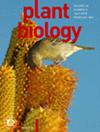Ontogenetic shifts in biomass allocation and xylem structure of the world's highest-occurring plants: balancing growth, storage, and resilience in the extreme Himalayan subnival zone
IF 3.6
3区 生物学
Q1 PLANT SCIENCES
引用次数: 0
Abstract

世界最高海拔植物生物量分配和木质部结构的个体发生变化:喜马拉雅极端亚寒带平衡生长、储存和恢复力。
了解植物如何将生物量分配给不同的器官和组织类型,对于揭示它们在生命阶段和环境中的适应策略至关重要。本研究研究了喜马拉雅亚寒带长寿命高山草本植物Ladakiella klimesii生物量分配的个体发生变化,以了解植物如何适应极端环境。研究人员测量了205个个体的根、茎和叶的生物量分布,以及木质部组织组成,以确定植物大小和年龄如何影响不同发育阶段的资源优先级。根颈横截面被检查以确定植物年龄,年生长增量和组织分数。较小的植物优先考虑根系吸收养分,而较大的植物则将更多的生物量分配给薄壁组织进行储存和代谢活动。木质素化组织随着大小的增加而减少,反映了结构需求的减少,而年轻植株的血管分数和径向生长更高,以支持水分运输。年龄独立地调节了这些模式,年轻的植物专注于建立结构,而年长的植物则强调储存组织的弹性。Ladakiella klimesii通过狭窄的木质部血管来适应极端的低空区,以防止冰冻引起的栓塞,缺乏纤维以最大限度地降低冰冻风险,高叶质量组分以优化短生长季节的光合作用。其简化的木质部结构,以薄壁组织和单木质素化的导管排为主,反映了热约束和功能效率。这些发现强调了整合植物大小和年龄在生态学研究中的重要性,并强调了该物种在具有挑战性的亚热带环境中茁壮成长的专门策略。
本文章由计算机程序翻译,如有差异,请以英文原文为准。
求助全文
约1分钟内获得全文
求助全文
来源期刊

Plant Biology
生物-植物科学
CiteScore
8.20
自引率
2.60%
发文量
109
审稿时长
3 months
期刊介绍:
Plant Biology is an international journal of broad scope bringing together the different subdisciplines, such as physiology, molecular biology, cell biology, development, genetics, systematics, ecology, evolution, ecophysiology, plant-microbe interactions, and mycology.
Plant Biology publishes original problem-oriented full-length research papers, short research papers, and review articles. Discussion of hot topics and provocative opinion articles are published under the heading Acute Views. From a multidisciplinary perspective, Plant Biology will provide a platform for publication, information and debate, encompassing all areas which fall within the scope of plant science.
 求助内容:
求助内容: 应助结果提醒方式:
应助结果提醒方式:


